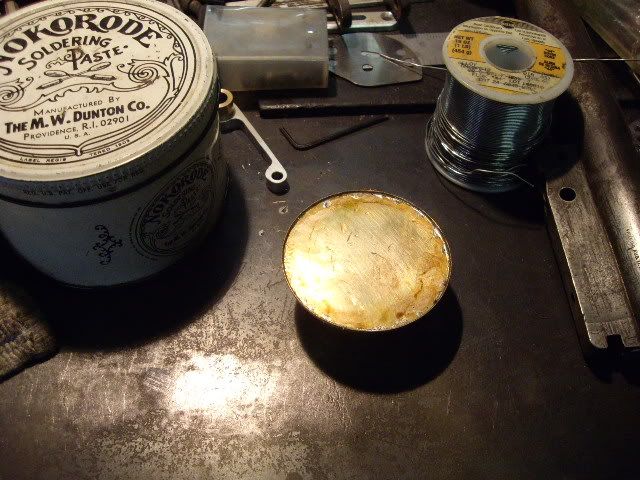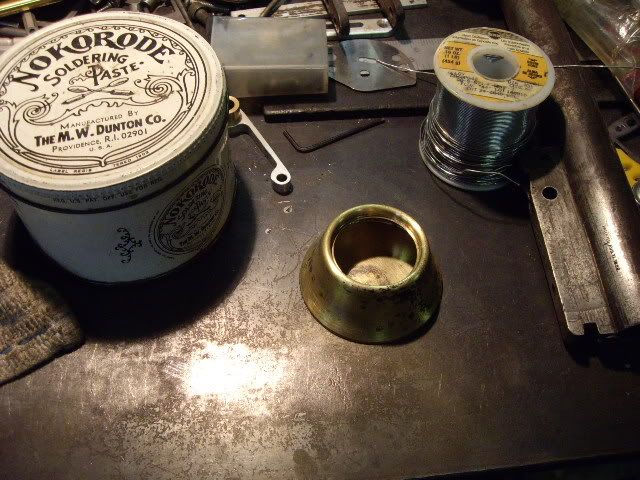Hi Olli, all, well, getting it running was first, but it needed its own burner, to keep the wick out of the valve reed, so I took an extra bezel from a door lock, set it on fire to burn off all the laquer which was coating it, having saved it for just such an occasion, as I can't throw away bits of brass or anything which looks like it could be built into something, scrubbed off the burnt laquer and with a piece of kick plate from an old front door, made a round disc for a bottom, cleaned everything up well, painted it with Nocorrode soldering flux, got out my Sn63/37 Eutectic solder, heated the plate with a very small torch, and soldered the plate in place

I mention the solder because it is designed for perfect solder joints in high tech electronics, and it is the easiest alloy to use for soft soldering, as it melts at a low temperature, and flows like water, when everything is clean and well fluxed. It's more expensive than plumbing solder, because of the higher tin content, but well worth the difference because it behaves so well.

this is a top view, I also drilled a hole in the side, close up to the top, and inserted a piece of brass tube to hold the wick at the right height, and since the top is recessed, with a lip inside, I took another piece of kickplate brass, about .030 thick, cut a circle which would drop in the recess and sit on the lip, drilled a .062 hole in it, and soldered in a short piece of tubing in to act as both a vent and something to grip to remove the lid, with it just setting in place.
I'm trying to down load a new video which shows the engine running after getting warmed up. I put a piece of reflective tape on the flywheel so my lazer tach reads, and it runs about 275 rpm while warming up and quacking, but once it is warm, it goes up as high as 670 rpm, and sounds like the clatter of a loose engine, as the valve plate springs open and closed, with the vacuum determining the time of valve opening, letting the valve gear loose all at once, each cycle. It doesn't much quack once it gets going, I believe that is the valve reed quacking as the excess air is pushed past it, like a musical reed, while it is cold enough to hold in place and fully follow the cam with the moisture generated sealing the reed tightly forcing the engine to forcibly pull the valve loose, and produce the duck I can't find.
I started it with the cam where it seemed it ought to go, but once it was warmed, it needed much more advance, and now is hard starting, cold, but runs much stronger and faster once warmed up. I started with a .004 brass feeler gauge reed which made for easy starts, because of a great seal, even cold, but ended up flapping like a piece of paper when the engine was hot, and grabbing the wick of the burner and pulling it in closer to the engine, and blocking the port closing. I now have a .006 inch steel feeler gauge valve which is a bit stiffer, harder to start, but will hold up better when hot.
The use of "the poppin'" valve set up is what allowed me to get this engine to run, along with moving the mount behind the cylinder, and changing the dynamics of the heat. The head and cylinder will get quite hot while running, but it will run nicely for ten or fifteen minutes or more but ending up needing cleaning out of residue left from burning oil and moisture, a quick spray of WD-40 washes it all out, and wipes off the goo. The crank standard, aluminum and mounted to the cylinder rear also gets quite hot, and the stainless steel mount plate, inserted between standard and cylinder, isolates the heat from the aluminum side plates which hold up the engine, something that would be better in aluminum to provide better cooling. With a stainless steel plate behind the head, I suspect the engine would have run in that set up, but the aluminum mount I had transferred the heat from the head and cylinder too fast I believe.
All in all, a very satisfying project as a first engine of my own design and I've learned a lot about the cams, advance, and other aspects of these small atmospheric engines, and will be building more with the knowledge gained here.
http://s894.photobucket.com/albums/ac150/madjackghengis/?action=view¤t=_0005-15.mp4Here's a thirty second clip of it running at temperature with its very own burner.